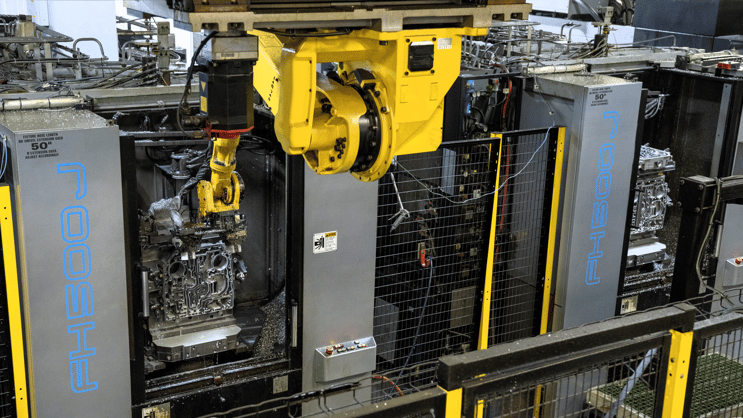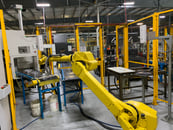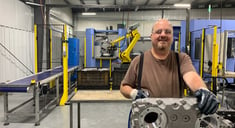Most modern manufacturers are dealing with a new norm: fewer skilled humans to handle rising production demands. The only way to succeed is by automating production processes to save time, achieve desired results, and reduce errors.
Manufacturing automation uses technology and machines — programmable devices, artificial intelligence, computer-controlled machines, and robots (more on these later) — to handle tasks without human intervention.
Those of us in the CNC machining world already know how automation helps us do more with less (in less time). After all, CNC stands for “computer numerical control,” so we’ve seen automation handling the control, movement, and precision of machine tools.
Key Benefits of Manufacturing Automation in a CNC Shop
All businesses should be exploring ways to minimize manual processes for quicker outcomes and reduce the dependence on skilled resources. CNC shops have historically been on the leading edge, turning to technological advancements to stay efficient and nimble.
Automation tools help ensure shops stay lean and productive while providing these key benefits:
Productivity Boost — Automation tools and technologies boost efficiency. With automation operating continuously (not needing breaks or rest), CNC shops achieve more in less time with fewer resources. Robots are programmed to keep machines running in cycle, ensuring spindles are turning and making chips.
System Integration — To improve operations, integration is crucial, especially real-time status of equipment. Sensor inputs and error codes provide a live overview of operations and can prevent potential issues in advance.
Repeatability — Simple errors, such as incorrect orders or poor data entry, for instance, take up valuable time and can damage a shop’s reputation with a customer. Automation helps ensure more reliable data and reduces costly mistakes.
Job Enhancement — Automation is not a threat to jobs, but a valuable asset, reducing routine tasks and allowing employees to focus on strategic tasks. Operators can focus on quality and maintaining tooling. The result is more job satisfaction and increased positive business outcomes.
Types of Automation
There is no single great example of manufacturing automation because different types of automation are used to solve different needs.
Fixed automation is the best automation type for fast production of a singular product and includes automated assembly machines, chemical manufacturing processes, and material handling conveyor systems.
Flexible automation allows for a mixture of products and often involves the use of industrial robots for tasks such as arc welding, spot welding, materials handling, machine tending, painting, assembly, and mechanical cutting.
Programmable automation is ideal for manufacturers making batches of different products, including computer numerically controlled (CNC) machine tools, programmable logic controllers (PLCs), and industrial robots.
Why Use Robotics for CNC Machining?
Moving along a predetermined path to perform a precise machining operation (milling, drilling, turning, cutting, etc.) is the foundation of CNC machining. Robotics take that precision and offer even more versatility and reliability, such as the lifting of heavy, complex, or multi-operation parts.
Why lean on robotics for your CNC machining? We’ve got 6 answers!
- Increased Precision and Accuracy: Yes we mentioned this, yet producing high-quality parts requires performing the same machining operations with consistent accuracy that robots can provide.
- Versatility: Properly programmed robots can seamlessly transition from one task to another and perform multiple tasks, which is beneficial for diverse machining needs.
- Reliability: Robots will not suffer from fatigue, or need to take breaks, or be distracted, making them highly reliable for continuous operation.
- Rapid Production: Robots produce parts with extremely quick lead times, allowing for rapid iteration for prototypes and quick delivery of custom parts.
- Resource Reallocation: Manufacturers can reallocate labor to more productive and challenging tasks, as robots handle repetitive tasks such as machine tending.
- Multi-Operation Part Machining: Robots handle multiple operations at a time, which is beneficial for parts that require more than one CNC machining process.
The Trends That Will Drive CNC Manufacturing Automation This Year
Late last year, we shared thoughts on 2024 trends in CNC machining. Today, we’re more focused on the automation aspect of CNC machining.
Artificial intelligence is everywhere. Look for AI to play a larger role within automation CNC machining, helping to optimize processes, improve efficiency, and reduce errors. Leveraging technological advancements has always provided early adopting companies with a competitive edge, and this remains true in CNC machining today.
Labor issues challenges are ongoing. Automation can help address labor shortages and high labor costs throughout the manufacturing industry, including CNC shops. Hand-in-hand with that is the need to constantly increase production speeds and efficiency, and using advancements in technology to accomplish that.
The use of data analytics in CNC machining is expected to grow, helping operations make more informed decisions and improve their operations. Automation systems can use data to improve processes, help shorten lead times, increase unmanned hours, and ensure more stable workflows.
Invest Wisely in Manufacturing Automation
While a shift toward automation allows human workers to concentrate on complex tasks, it's vital to assess the production growth opportunities and savings potential of these automated systems before investing in them.
You should invest resources in identifying what you should automate. Not all tasks are right for automation, yet you can uncover some easy-to-implement, high-return examples to automate.
It's also crucial to ensure that employees understand and support automation’s benefits so any potential resistance to digital transformation is minimized. Training on new software is a key step to guarantee its effective and long-term use.
Lastly, it's essential to establish and monitor objectives for ongoing enhancement. For a CNC machine shop to experience positive and long-lasting change, it needs to define its goals and understand how automation will assist in reaching them.
Ready to go beyond automation? Learn how a CNC machine shop can dedicate itself to lean manufacturing (and enjoy the benefits). Read our e-Book: The Benefits of Lean Manufacturing in Machine Shops.






